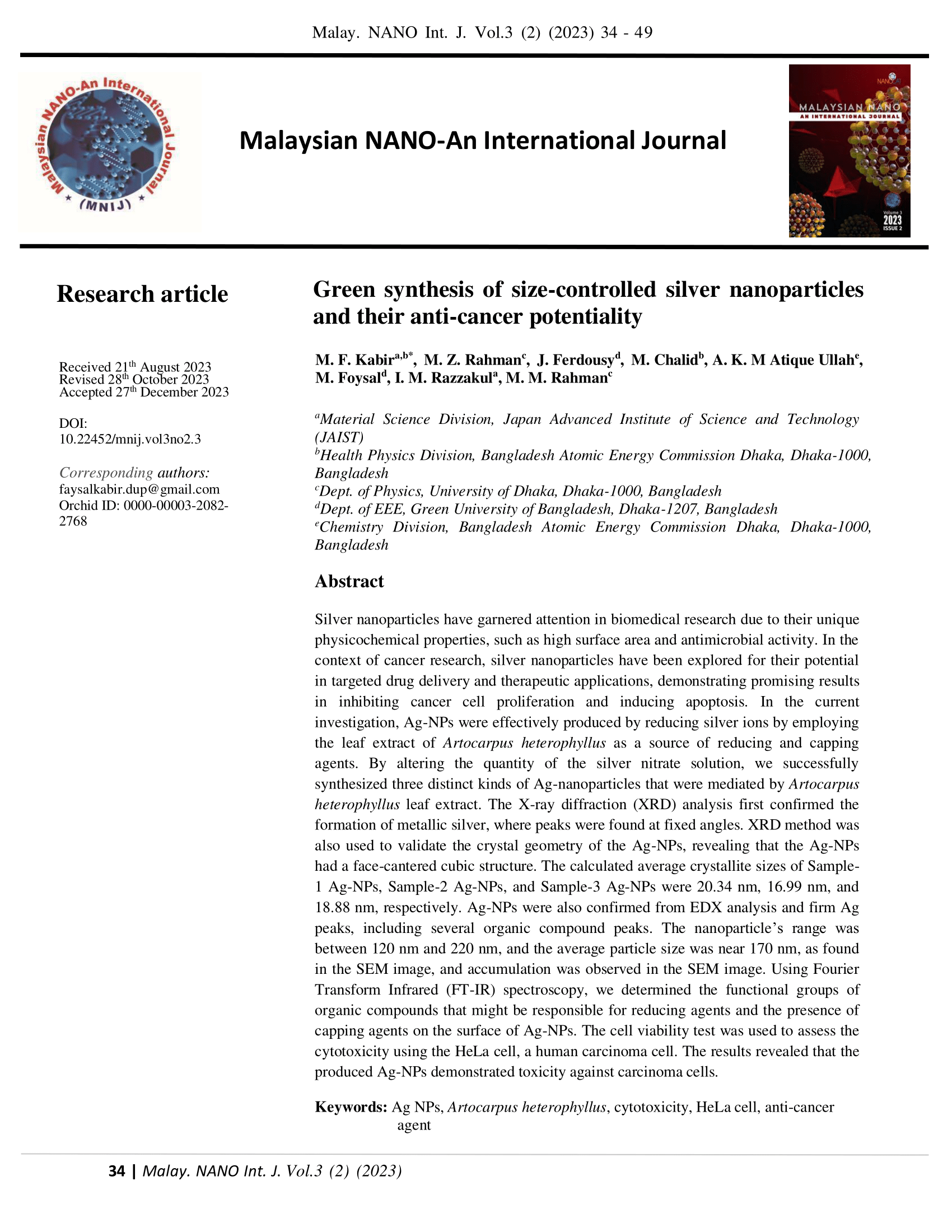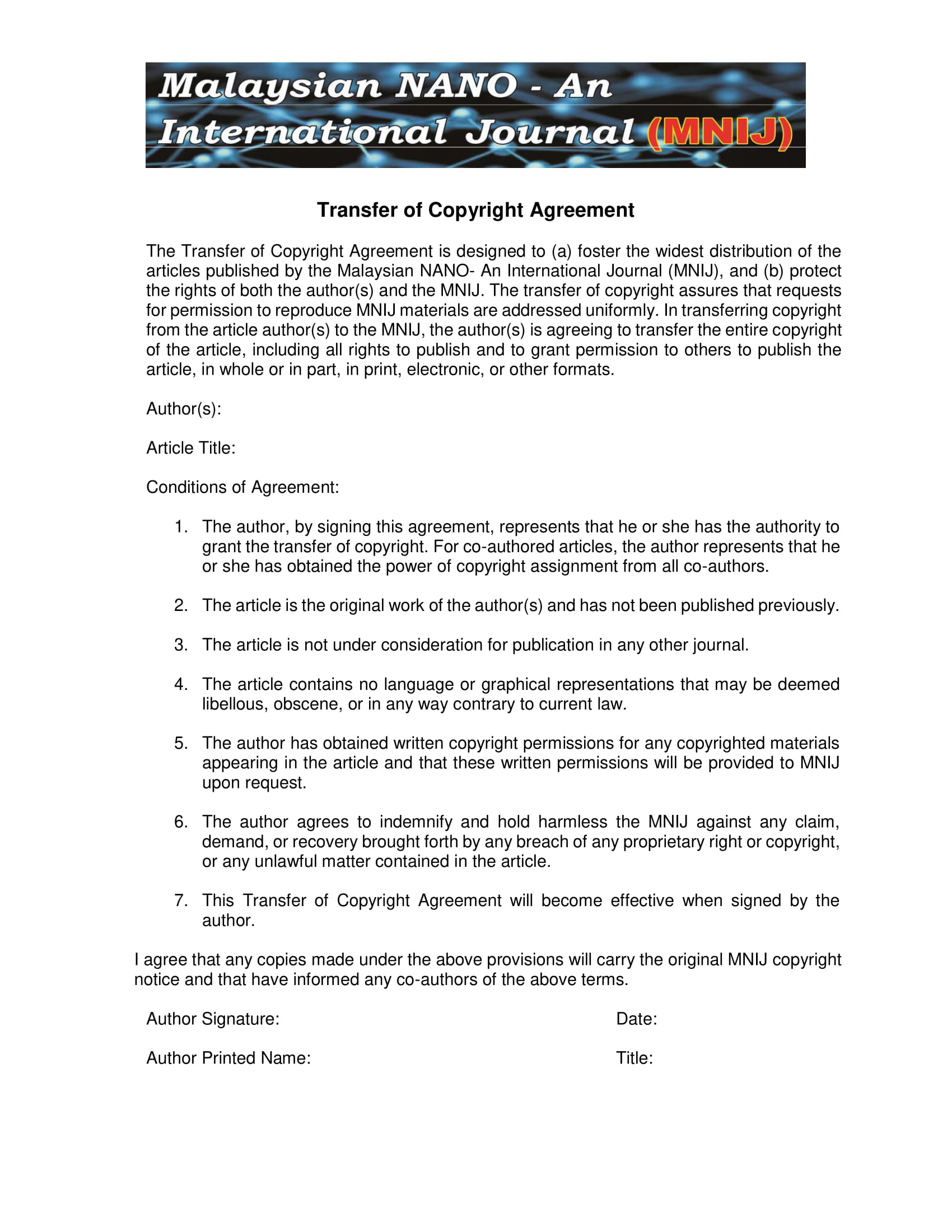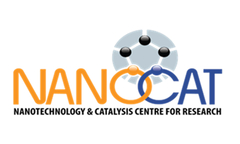Green synthesis of size-controlled silver nan particles and their anti-cancer potentiality
DOI:
https://doi.org/10.22452/mnij.vol3no2.3Keywords:
anti-cancer agent, HeLa cell, cytotoxicity, Artocarpus heterophyllus, Ag NPsAbstract
Silver nanoparticles (Ag-NPs) are now well recognized as one of the most prevalent kinds of materials that are put to use in a wide variety of biomedical applications, most notably as an anti-cancer agent. In the current investigation, Ag-NPs were effectively produced by reducing silver ions by employing the leaf extract of Artocarpus heterophyllus as a source of reducing and capping agents. By altering the quantity of the silver nitrate solution, we successfully synthesized three distinct kinds of Ag-nanoparticles that were mediated by Artocarpus heterophyllus leaf extract. The X-ray diffraction (XRD) analysis first confirmed the formation of metallic silver, where peaks were found at fixed angles. XRD method was also used to validate the crystal geometry of the Ag-NPs, revealing that the Ag-NPs had a face-cantered cubic structure. The calculated average crystallite sizes of Sample-1 Ag-NPs, Sample-2 Ag-NPs, and Sample-3 Ag-NPs were 20.34 nm, 16.99 nm, and 18.88 nm, respectively. Ag-NPs were also confirmed from EDX analysis and firm Ag peaks, including several organic compound peaks. The nanoparticle’s range was between 120 nm and 220 nm, and the average particle size was near 170 nm, as found in the SEM image, and accumulation was observed in the SEM image. Using Fourier Transform Infrared (FT-IR) spectroscopy, we determined the functional groups of organic compounds that might be responsible for reducing agents and the presence of capping agents on the surface of Ag-NPs. The cell viability test was used to assess the cytotoxicity using the HeLa cell, a human carcinoma cell. The results revealed that the produced Ag-NPs demonstrated toxicity against carcinoma cells.
Downloads
References
. T.V. Duncan, Applications of nanotechnology in food packaging and food safety: barrier materials, antimicrobials and sensors. Journal of colloid and interface science. 363, 1-24 (2011).
. C. Carlson, S. M. Hussain, A. M. Schrand, L. Braydich-Stolle, K. L. Hess, R. L. Jones, J. J. Schlager, Unique cellular interaction of silver nanoparticles: size-dependent generation of reactive oxygen species. The journal of physical chemistry B. 112,13608-13619 (2008).
. M. Akter, A. A. Ullah, M. S. Rahaman, M. M. Rahman, M. T. Sikder, T. Hosokawa, T. Saito, M. Kurasaki, Stability enhancement of silver nanoparticles through surface encapsulation via a facile green synthesis approach and toxicity reduction. Journal of Inorganic and Organometallic Polymers and Materials. 30,956-1965 (2020).
. R. Balachandar, R. Navaneethan, M. Biruntha, K. K. A. Kumar, M. Govarthanan, N. Karmegam, Antibacterial activity of silver nanoparticles phytosynthesized from Glochidion candolleanum leaves. Materials Letters. 311,131572-131583 (2022).
. S. Dutta, B. N. Ganguly, Characterization of ZnO nanoparticles grown in presence of Folic acid template. Journal of nanobiotechnology. 10,1-10 (2012).
. R. S. Patil, M. R. Kokate, S. S. Kolekar, Bioinspired synthesis of highly stabilized silver nanoparticles using Ocimum tenuiflorum leaf extract and their antibacterial activity. Spectrochimica Acta Part A: Molecular and Biomolecular Spectroscopy. 91, 234-238 (2012).
. M. Akter, A. K. M. Atique Ullah, S. Banik, M. T. Sikder, T. Hosokawa, T. Saito, M. Kurasaki, Green synthesized silver nanoparticles-mediated cytotoxic effect in colorectal cancer cells: NF-κB signal induced apoptosis through autophagy. Biological Trace Element Research. 199, 3272-3286 (2021).
. J. H. Sung, J. H. Ji, J. D Park, J. U. Yoon, D. S. Kim, K.S. Jeon,M. Y. Song, J. Jeong, B. S. Han, J. H. Han, Y. H. Chung, Subchronic inhalation toxicity of silver nanoparticles. Toxicological sciences. 108, 452-461 (2009).
. N. H. Rezazadeh, F. Buazar, S. Matroodi, Synergistic effects of combinatorial chitosan and polyphenol biomolecules on enhanced antibacterial activity of biofunctionalized silver nanoparticles. Scientific reports. 10, 1-13 (2020).
. G. H. Palliyage, N. Hussein, M. Mimlitz, C. Weeder, M. H. A. Alnasser, S. Singh, A. Ekpenyong, A. K. Tiwari, H. Chauhan, Novel Curcumin-Resveratrol Solid Nanoparticles Synergistically Inhibit Proliferation of Melanoma Cells. Pharmaceutical Research. 38, 851-871 (2021).
. B. Schaefer, M. Tobiasch, S. Wagner, B. Glodny, H. Tilg, M. Wolf, H. Zoller, Hypophosphatemia after intravenous iron therapy: comprehensive review of clinical findings and recommendations for management. Bone. 154, 116202-116213 (2022).
. M. F. Kabir, A. A. Ullah, J. Ferdousy, M. M. Rahman, anticancer efficacy of biogenic silver nanoparticles in vitro. SN Applied Sciences. 2, 1-8 (2020).
. X. U. Vu, T. T. T. Duong, T. T. H. Pham, D. K. Trinh, X. H. Nguyen, V. S. Dang, Synthesis and study of silver nanoparticles for antibacterial activity against Escherichia coli and Staphylococcus aureus. Advances in Natural Sciences: Nanoscience and Nanotechnology. 9, 025019 -025027 (2018).
. R. S. Shinde, R. A. More, V. A. Adole, P.B. Koli, T. B. Pawar, B. S. Jagdale, B. S. Desale, Y. S. Sarnikar, Design, fabrication, antitubercular, antibacterial, antifungal and antioxidant study of silver doped ZnO and CuO nano candidates: A comparative pharmacological study. Current Research in Green and Sustainable Chemistry. 4,100138 -100147 (2021).
. M. P. Patil, R. D. Singh, P. B. Koli, K. T. Patil, B. S. Jagdale, A. R. Tipare, G. D. Kim, Antibacterial potential of silver nanoparticles synthesized using Madhuca longifolia flower extract as a green resource. Microbial pathogenesis. 121, 184-189 (2018).
. S. Ali, X. Chen, M. A. Shah, M. Ali, M. Zareef, M. Arslan, S. Ahmad, T. Jiao, H. Li, Q. Chen, The avenue of fruit wastes to worth for synthesis of silver and gold nanoparticles and their antimicrobial application against foodborne pathogens: A review. Food Chemistry. 359, 129912-129921 (2021).
. M. Bagheri, M. Heydari, P. Sangpour, S. Rabieh, In situ green synthesis of cellulose nanocomposite films incorporated with silver/silver chloride particles: characterization and antibacterial performance. Chemical Papers. 76, 6223-6233 (2022).
. W. Hao, R. Chen, Y. Zhang, Y. Wang, Y. Zhao, Triazine-Based Conjugated Microporous Polymers for Efficient Hydrogen Production. ACS omega. 6, 23782-23787 (2021).
. M. Kannan, K. Elango, T. Tamilnayagan, S. Preetha, G. Kasivelu, Impact of nanomaterials on beneficial insects in agricultural ecosystems. Nanotechnology for food, agriculture, and environment. 2, 379-393 (2020).
. M. A. Rasool, G. K. Gautam, D. P. Panda, D. C. Sahu, Preparation, Characterisation and Antifungal activity of Gold Nanoparticles prepared with Fresh Extract of Aconitum heterophyllum leaves. Research Journal of Pharmacy and Technology. 15, 3245-3250 (2022).
. A. M. A. Ullah, M. F. Kabir, M. Akter, A. N. Tamanna, A. Hossain, A. R. A. Tareq, M. N. I. Khan, A. F. Kibria, M. Kurasaki, M. M. Rahman, Green synthesis of bio-molecule encapsulated magnetic silver nanoparticles and their antibacterial activity. RSC advances. 8, 37176-37183 (2018).
. D. A. Kusumaningtyas, H. Khoirudin, M. Tami, M. U. Sari, A. Nirsatmanto, A. D. Nugraheni, F. Nugroho, Eucalyptus Leaves as Potential Indicators of Gold Mine in Indonesia. Jurnal Penelitian Pendidikan IPA. 8, 45-50 (2022).
. D. Decker, L. A. Kleczkowski, UDP-sugar producing pyrophosphorylases: distinct and essential enzymes with overlapping substrate specificities, providing de novo precursors for glycosylation reactions. Frontiers in Plant Science. 9, 1822-1833 (2019).
. S.D. Doke, C. M. Patel, V. N. Lad, Improving performance of the synthesis of silica nanoparticles by surfactant-incorporated wet attrition milling. Silicon. 1,1-10 (2021).
. P. Aswathi, J. E. Thoppil, Synthesis and physicochemical characterization of silver nanoparticles from the dye-yielding plants, Terminalia paniculata and Mallotus philippensis. Nanotechnology for Environmental Engineering. 1, 1-10 (2022).
. L. Tabassam, M. J. Khan, S. Hussain, S. A. Khattak, S. K. Shah, A. S. Bhatti, Structural, optical and antimicrobial characteristics of ZnO green nanoparticles. Journal of Sol-Gel Science and Technology. 101, 401-410 (2022).
. L. Xu, Z. Xu, X. Liao, A review of fruit juice authenticity assessments: Targeted and untargeted analyses. Critical Reviews in Food Science and Nutrition. 62, 6081-6102 (2022).
. M. Akter, M. M. Rahman, A. A. Ullah, M. T. Sikder, T. Hosokawa, T. Saito, M. Kurasaki, Brassica rapa var. japonica leaf extract mediated green synthesis of crystalline silver nanoparticles and evaluation of their stability, cytotoxicity and antibacterial activity. Journal of Inorganic and Organometallic Polymers and Materials. 28, 1483-1493 (2018).
. B. W. Stuart, G. E. Stan, A. C. Popa, M. J. Carrington, I. Zgura, M. Necsulescu, D. M. Grant, New solutions for combatting implant bacterial infection based on silver nano-dispersed and gallium incorporated phosphate bioactive glass sputtered films: A preliminary study. Bioactive Materials. 8, 325-340 (2022).
. M. Akter, M. T. Sikder, M. M. Rahman, A. A. Ullah, K. F. B. Hossain, S. Banik, T. Hosokawa, T. Saito, M. Kurasaki, A systematic review on silver nanoparticles-induced cytotoxicity: Physicochemical properties and perspectives. Journal of advanced research. 9, 1-16 (2018).

Downloads
Published
How to Cite
Issue
Section
License





